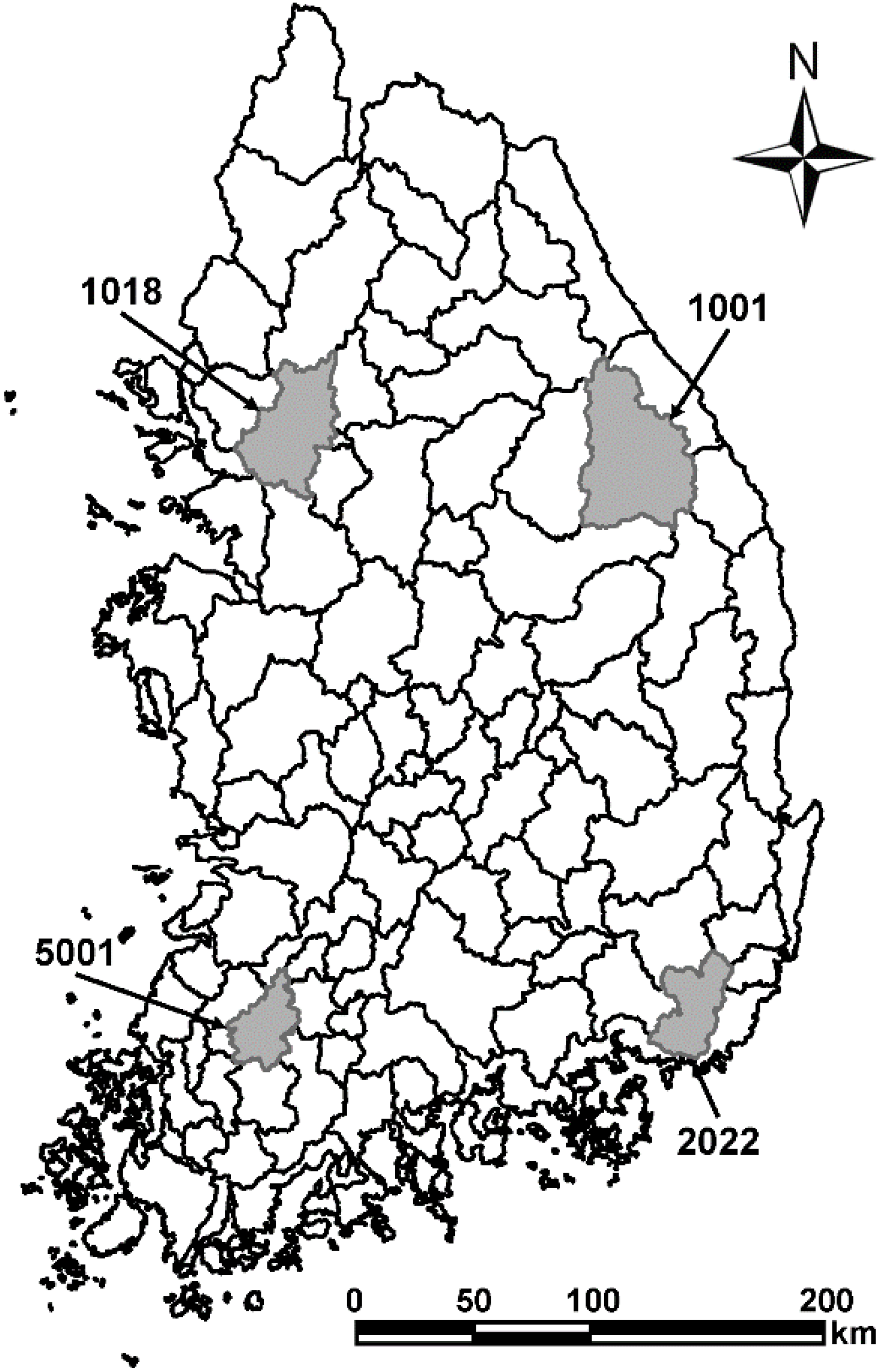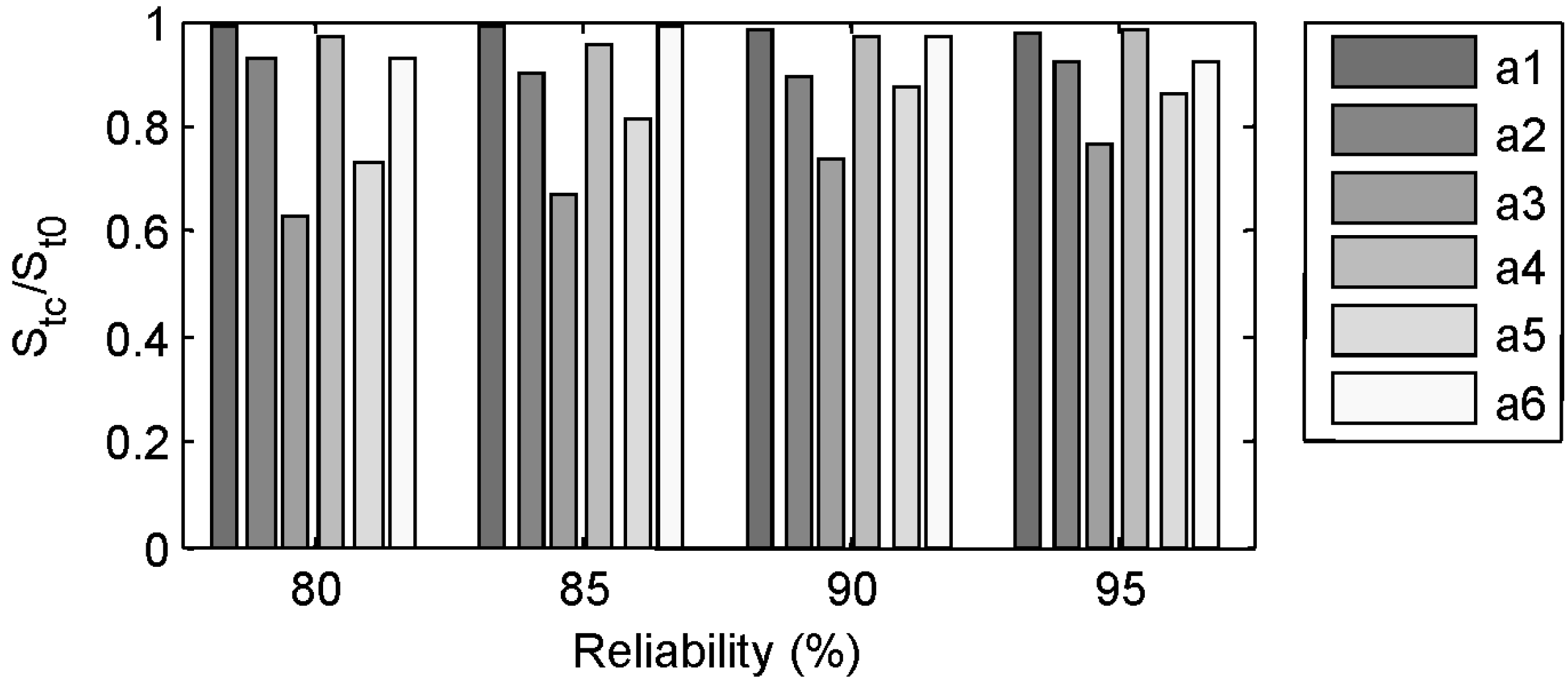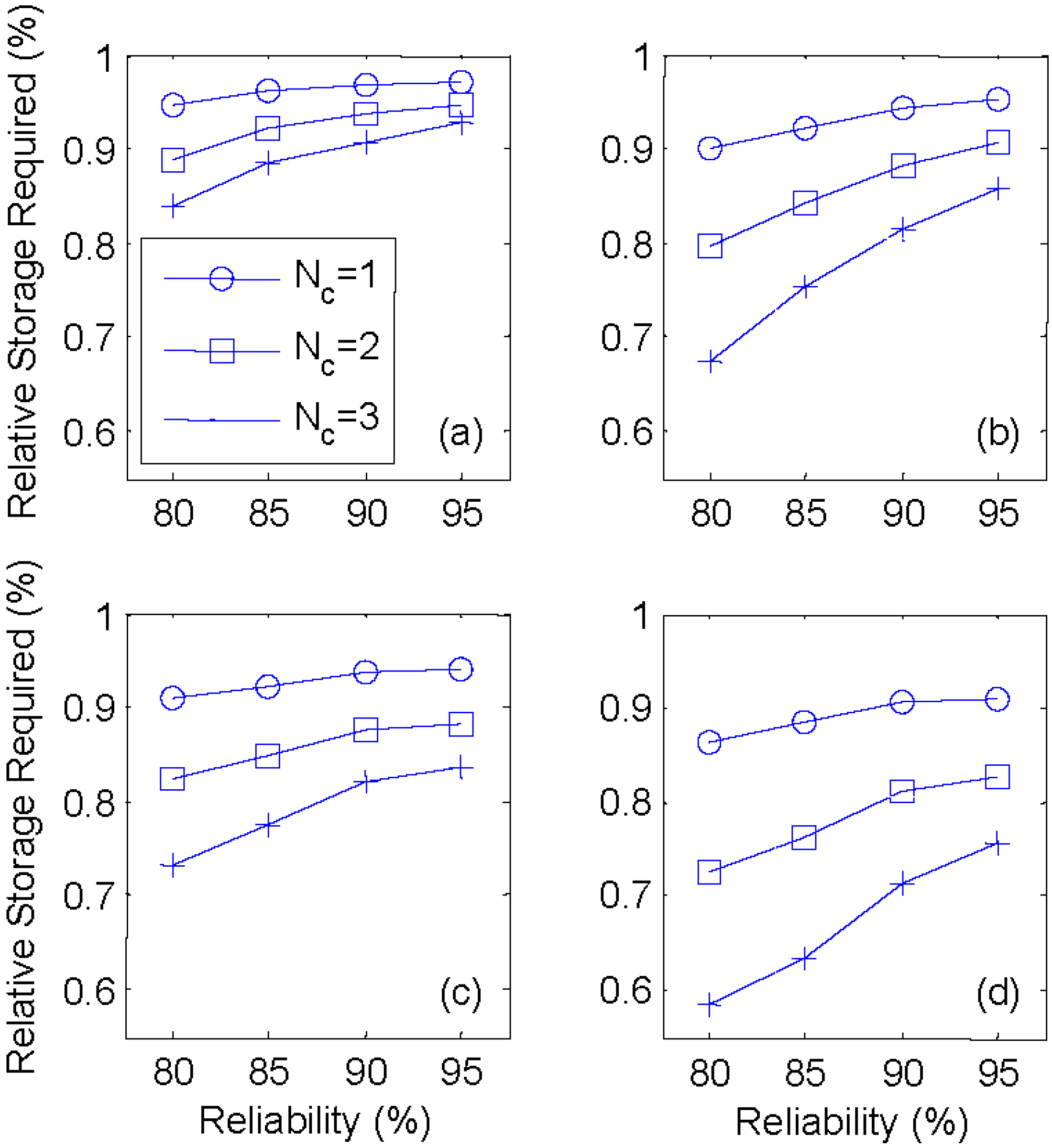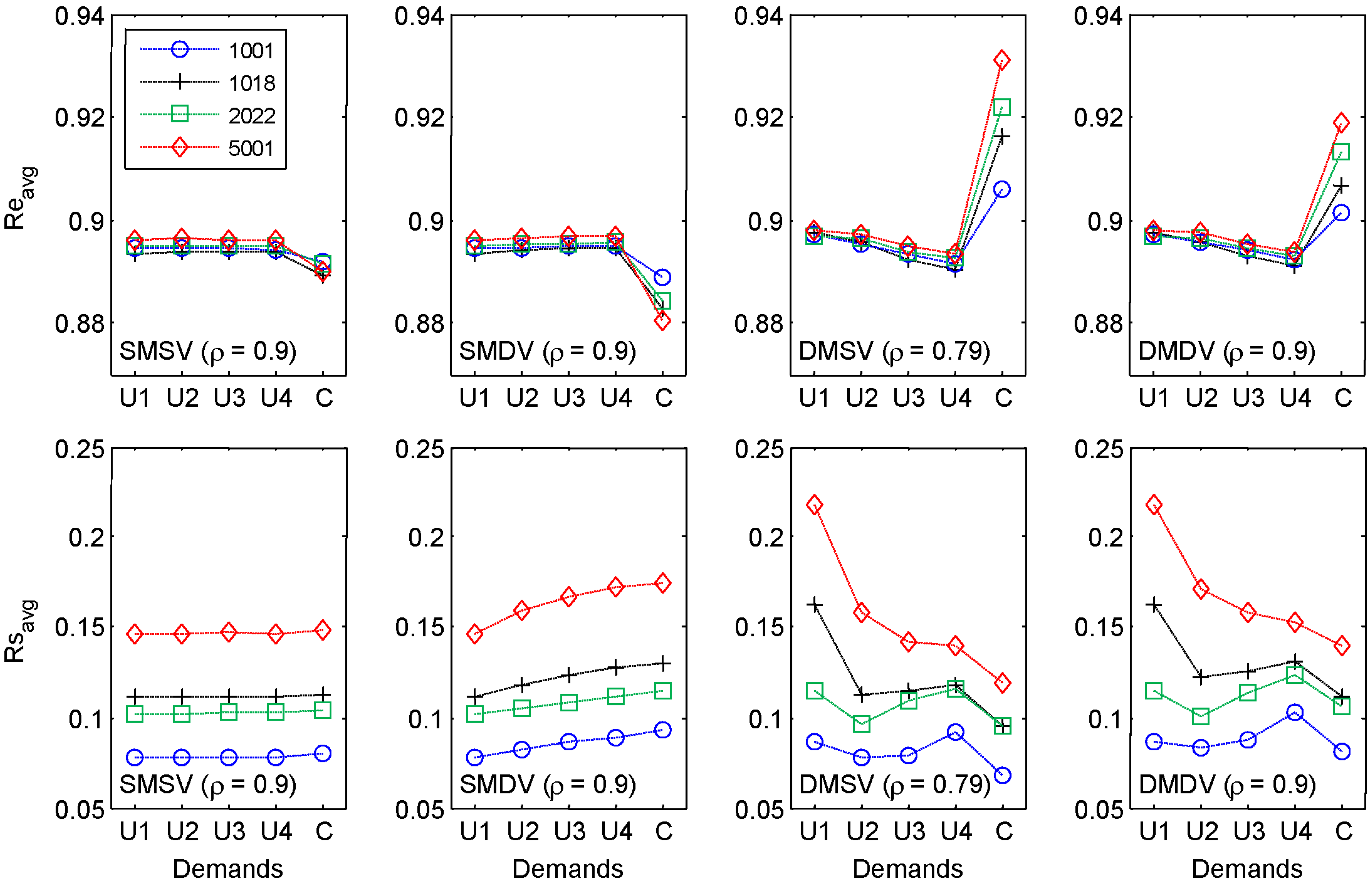Potential Benefits from Sharing Rainwater Storages Depending on Characteristics in Demand
Abstract
:1. Introduction
2. Methodology
2.1. Characteristics in Water Demand
| Cases | Correlation (ρ) | Mean (μ) | Variance (σ2) |
|---|---|---|---|
| Same Mean/Same Variance (SMSV) | 0, 0.90 | μ1, 2, 3, 4 = 0.5 | σ21, 2, 3, 4 = 0.25 |
| Same Mean/Different Variances (SMDV) | σ21 = 0.25, σ22 = 0.50, σ23 = 0.75, σ24 = 1.0 | ||
| Different Means/Same Variance (DMSV) | 0, 0.79 | μ1 = 0.2 μ2 = 0.4 μ3 = 0.6 μ4 = 0.8 | σ21, 2, 3, 4 = 0.25 |
| Different Means/Different Variances (DMDV) | 0, 0.90 | σ21 = 0.25, σ22 = 0.50, σ23 = 0.75, σ24 = 1.00 |
2.2. Networks for RWHSs
| No. of Connections (Nc) | Possible Sharing Networks of Individual Rain Barrels | |||||||||||
|---|---|---|---|---|---|---|---|---|---|---|---|---|
| 1 |  |  |  |  |  |  | ||||||
| (a1) | (a2) | (a3) | (a4) | (a5) | (a6) | |||||||
| 2 |  |  |  |  |  |  |  | |||||
| (b1) | (b2) | (b3) | (b4) | (b5) | (b6) | (b7) | ||||||
| 3 |  | |||||||||||
| (c1) | ||||||||||||
2.3. Test Catchments in South Korea

| Catchment | Area (km2) | Name of the City | River Name | Yearly Mean Precipitation * (mm) |
|---|---|---|---|---|
| 1001 | 2448 | Gangneung | Han River | 1320 |
| 1018 | 1537 | Seoul | Han River | 1248 |
| 2022 | 916 | Busan | Nakdong River | 1380 |
| 5001 | 715 | Gwangju | Yeongsan River | 1356 |
2.4. Storage-Reliability-Yield (SRY) Method

3. Results and Discussion
3.1. Storage-Reliability-Yield (SRY) Analysis for a Sharing Network of RWHSs


3.2. Demand Characteristics in Water Demand and the Benefit from the Sharing Network


| Catchment | ρ | Target Reliability (%) | |||
|---|---|---|---|---|---|
| 80 | 85 | 90 | 95 | ||
| 1001 | 0 | 0.84 | 0.89 | 0.91 | 0.91 |
| 0.9 | 0.81 | 0.87 | 0.90 | 0.92 | |
| 1018 | 0 | 0.72 | 0.79 | 0.84 | 0.87 |
| 0.9 | 0.69 | 0.78 | 0.83 | 0.87 | |
| 2022 | 0 | 0.70 | 0.77 | 0.81 | 0.81 |
| 0.9 | 0.68 | 0.76 | 0.81 | 0.81 | |
| 5001 | 0 | 0.61 | 0.65 | 0.72 | 0.74 |
| 0.9 | 0.59 | 0.63 | 0.71 | 0.74 | |



4. Conclusions
Acknowledgments
Author Contributions
Conflicts of Interest
References
- Pacey, A.; Cullis, A. Rainwater Harvesting: The Collection of Rainfall and Runoff in Rural Areas; ITDG Publishing: London, UK, 1986. [Google Scholar]
- Ludwig, A. Water Storage: Tanks, Cisterns, Aquifers, and Ponds for Domestic Supply, Fire and Emergency Use; Oasis Design: Santa Barbara, CA, USA, 2005. [Google Scholar]
- Su, M.-D.; Lin, C.-H.; Chang, L.-F.; Kang, J.-L.; Lin, M.-C. A probabilistic approach to rainwater harvesting systems design and evaluation. Resour. Conserv. Recycl. 2009, 53, 393–399. [Google Scholar] [CrossRef]
- Abdulla, F.A.; Al-Shareef, A.W. Roof rainwater harvesting systems for household water supply in Jordan. Desalination 2009, 243, 195–207. [Google Scholar] [CrossRef]
- Fewkes, A. Modelling the performance of rainwater collection systems: Towards a generalized approach. Urban Water 2000, 1, 323–333. [Google Scholar] [CrossRef]
- Ghisi, E.; Bressan, D.L.; Martini, M. Rainwater tank capacity and potential for potable water savings by using rainwater in the residential sector of southeastern Brazil. Build Environ. 2007, 42, 1654–1666. [Google Scholar] [CrossRef]
- Imteaz, M.A.; Rahman, A.; Ahsan, A. Reliability analysis of rainwater tanks: A comparison between South-East and Central Melbourne. Resour. Conserv. Recycl. 2012, 66, 1–7. [Google Scholar] [CrossRef]
- Basinger, M.; Montalto, F.; Lall, U. A rainwater harvesting system reliability model based on nonparametric stochastic rainfall generator. J. Hydrol. 2010, 392, 105–118. [Google Scholar] [CrossRef]
- Villarreal, E.L.; Dixon, A. Analysis of a rainwater collection system for domestic water supply in Ringdansen, Norrköping, Sweden. Build Environ. 2005, 40, 1174–1184. [Google Scholar] [CrossRef]
- Fox, P.; Rockström, J.; Barron, J. Risk analysis and economic viability of water harvesting for supplemental irrigation in semi-arid Burkina Faso and Kenya. Agric. Syst. 2005, 83, 231–250. [Google Scholar] [CrossRef]
- Liaw, C.H.; Tsai, Y.L. Optimum storage volume of rooftop rain water harvesting systems for domestic use. J. Am. Water Resour. Assoc. 2004, 40, 901–912. [Google Scholar] [CrossRef]
- Daigger, G.T. Evolving urban water and residuals management paradigms: Water reclamation and reuse, decentralization, and resource recovery. Water Environ. Res. 2009, 81, 809–823. [Google Scholar] [CrossRef] [PubMed]
- Jenkins, D.; Pearson, F.; Moore, E.; Sun, J.K.; Valentine, R. Feasibility of Rainwater Collection SYstem in California; California Water Resources Center, University of California: Davis, CA, USA, 1978. [Google Scholar]
- Mitchell, V.G. How important is the selection of computational analysis method to the accuracy of rainwater tank behaviour modelling? Hydrol. Process. 2007, 21, 2850–2861. [Google Scholar] [CrossRef]
- Guo, Y.P.; Baetz, B.W. Sizing of rainwater storage units for green building applications. J. Hydrol. Eng. 2007, 12, 197–205. [Google Scholar] [CrossRef]
- Howard, C. Theory of storage and treatment-plant overflows. J. Environ. Eng. Div. 1976, 102, 709–722. [Google Scholar]
- Loganathan, G.V.; Delleur, J.W. Effects of urbanization on frequencies of overflows and pollutant loadings from storm-sewer overflows—A derived distribution approach. Water Resour. Res. 1984, 20, 857–865. [Google Scholar] [CrossRef]
- Adams, B.; Papa, F. Urban Stormwater Management Planning with Analytical Probabilistic Models; John Wiley & Sons Inc: New York, NY, USA, 2000. [Google Scholar]
- Hanson, L.; Vogel, R.; Kirshen, P.; Shanahan, P.; Starrett, S. Generalized Storage-Reliability-Yield Equations Rainwater Harvesting Systems. In Proceedings of the World Environmental & Water Resources Congress 2009, Kansas City, MO, USA, 2009; pp. 1–10.
- Kuria, F.; Vogel, R. Global storage-reliability-yield relationships for water supply reservoirs. Water Resour. Manag. 2014, 29, 1591–1605. [Google Scholar]
- Imteaz, M.A.; Ahsan, A.; Naser, J.; Rahman, A. Reliability analysis of rainwater tanks in melbourne using daily water balance model. Resour. Conserv. Recycl. 2011, 56, 80–86. [Google Scholar] [CrossRef]
- Rahman, A.; Keane, J.; Imteaz, M.A. Rainwater harvesting in Greater Sydney: Water savings, reliability and economic benefits. Resour. Conserv. Recycl. 2012, 61, 16–21. [Google Scholar] [CrossRef]
- Seo, Y.; Choi, N.J.; Park, D. Effect of connecting rain barrels on the storage size reduction. Hydrol. Process. 2012, 26, 3538–3551. [Google Scholar] [CrossRef]
- Seo, Y.; Ahn, J.; Kim, Y.-O. The impact of climate change on the benefit of a rain barrel sharing network. Resour. Conserv. Recycl. 2013, 74, 66–74. [Google Scholar] [CrossRef]
- Young, R.A. Price elasticity of demand for municipal water: A case study of Tucson, Arizona. Water Resour. Res. 1973, 9, 1068–1072. [Google Scholar] [CrossRef]
- Maidment, D.; Parzen, E. Time patterns of water use in six Texas cities. J. Water Resour. Plan. Manag. 1984, 110, 90–106. [Google Scholar] [CrossRef]
- Balling, R.C.; Gober, P. Climate variability and residential water use in the city of Phoenix, Arizona. J. Appl. Meteorol. Climatol. 2007, 46, 1130–1137. [Google Scholar] [CrossRef]
- Rahman, M.; Yusuf, F.U.A.M.S. Rainwater harvesting and the reliability concept. In Proceedings of the 8th ASCE Specialty Conference on Probabilistic Mechanics and Structural Reliability, Washington, DC, USA, 2000.
- Surendran, S.; Tanyimboh, T.; Tabesh, M. Peaking demand factor-based reliability analysis of water distribution systems. Adv. Eng. Softw. 2005, 36, 789–796. [Google Scholar] [CrossRef]
- Xu, C.; Goulter, I. Reliability-based optimal design of water distribution networks. J. Water Resour. Plan. Manag. 1999, 125, 352–362. [Google Scholar] [CrossRef]
- Hajani, E.; Rahman, A. Reliability and cost analysis of a rainwater harvesting system in peri-urban regions of Greater Sydney, Australia. Water 2014, 6, 945–960. [Google Scholar] [CrossRef]
- Hashimoto, T.; Stedinger, J.R.; Loucks, D.P. Reliability, resiliency, and vulnerability criteria for water resource system performance evaluation. Water Resour. Res. 1982, 18, 14–20. [Google Scholar] [CrossRef]
© 2015 by the authors; licensee MDPI, Basel, Switzerland. This article is an open access article distributed under the terms and conditions of the Creative Commons Attribution license (http://creativecommons.org/licenses/by/4.0/).
Share and Cite
Seo, Y.; Park, S.Y.; Kim, Y.-O. Potential Benefits from Sharing Rainwater Storages Depending on Characteristics in Demand. Water 2015, 7, 1013-1029. https://doi.org/10.3390/w7031013
Seo Y, Park SY, Kim Y-O. Potential Benefits from Sharing Rainwater Storages Depending on Characteristics in Demand. Water. 2015; 7(3):1013-1029. https://doi.org/10.3390/w7031013
Chicago/Turabian StyleSeo, Yongwon, Sun Young Park, and Young-Oh Kim. 2015. "Potential Benefits from Sharing Rainwater Storages Depending on Characteristics in Demand" Water 7, no. 3: 1013-1029. https://doi.org/10.3390/w7031013
APA StyleSeo, Y., Park, S. Y., & Kim, Y.-O. (2015). Potential Benefits from Sharing Rainwater Storages Depending on Characteristics in Demand. Water, 7(3), 1013-1029. https://doi.org/10.3390/w7031013







